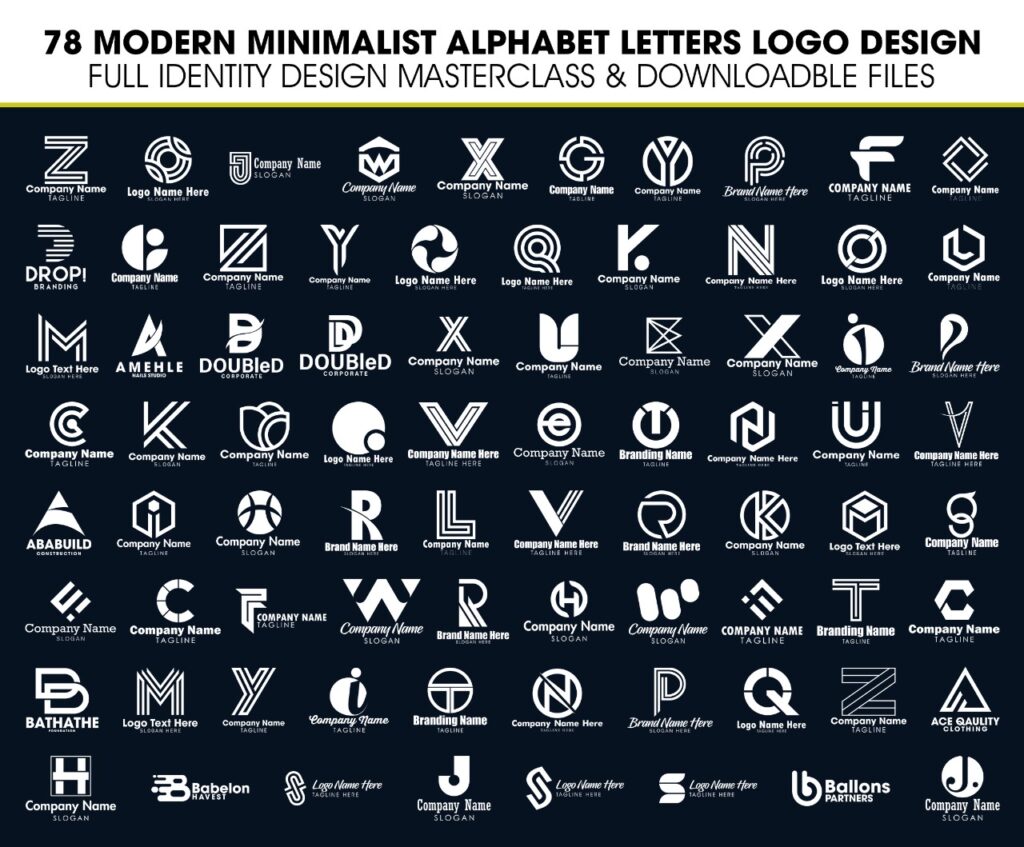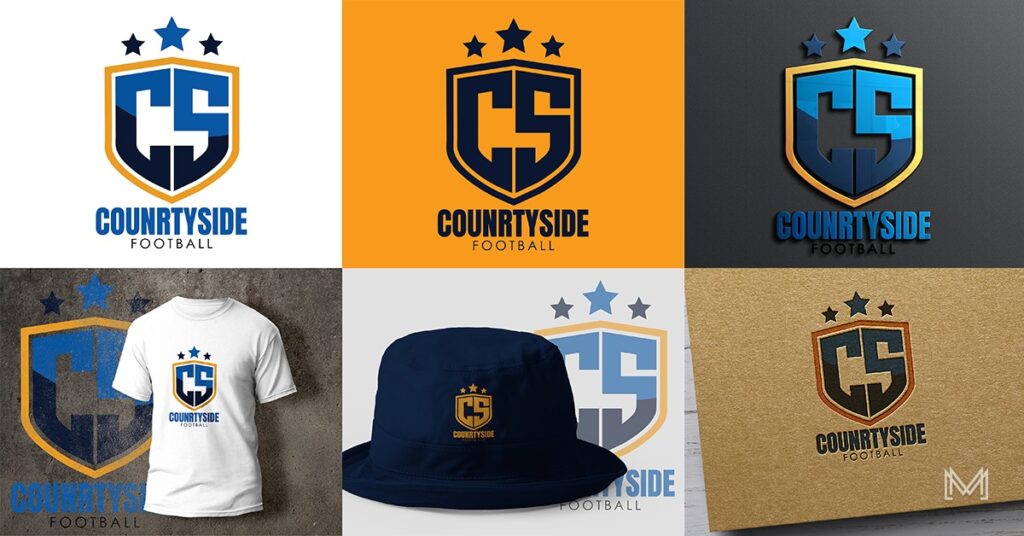The Art of Minimal Logo Design: In branding, less is more.
Designing a logo is essential in today’s fast-paced digital age, when people have short attention spans and first impressions are extremely important. One cannot overstate the importance of minimal logo design. A logo serves as a brand’s face, encapsulating its brand identity in a single visual identity.
Among the various styles and methods used in logo design, minimalism has emerged as an effective and enduring trend. Let us dig into the art of designing a basic logo and investigate the reasons why less is often more when it comes to branding.
Embracing Simplicity: The Essence of Minimal Logo Design
Simplicity stands out as a symbol of grace and clarity in the chaotic world of branding. A basic logo simplifies complicated ideas using simple lines, uncluttered compositions, and limited element utilisation. Minimalist logos have revolutionised company identities in a variety of sectors; just look at the ubiquitous Nike swoosh, the subtle grace of Apple’s bitten apple, or the immediately recognised Twitter bird.
Understanding the principles
Minimal logo design adheres to several fundamental principles:
- Simplicity involves emphasising the brand’s essence through uncomplicated visuals. Minimalism is about emphasising the main point and communicating it clearly.
- Clarity: ensuring instant recognition and memorability. A well-designed minimalist logo should be immediately recognisable and easily remembered by consumers.
- Versatility: adapting seamlessly across various platforms and scales. From tiny favicons to large billboards, a minimalist logo should maintain its impact and clarity across all mediums.
- Timelessness: evoking relevance and longevity through enduring design elements. A useful minimalist logo transcends trends and remains relevant for years to come, avoiding the need for frequent redesigns.
Explore the Path of Minimalism in Logo Design
Minimalism in logo design has evolved significantly, mirroring cultural, technological, and design landscape shifts. It’s fascinating to trace this evolution.
From complexity to simplicity
Historically, logos were often intricate and ornate, reflecting the prevailing design trends of their time. Think of the elaborate typography and detailed illustrations that were common in the late 19th and early 20th centuries. However, as attention spans shortened and visual clutter intensified, brands sought clarity amidst the chaos, leading to the rise of minimalism.
The Influence of Modernism
The modernist movement in design, with its emphasis on functionality and simplicity, had a profound impact on logo design. This influence is evident in the clean lines, geometric shapes, and sans-serif fonts that became characteristic of minimalist logos.
The Digital Age
The internet and digital media further accelerated the adoption of minimalist design. The need for logos that could easily display and recognise on small screens and in environments with limited bandwidth led to the emergence of a new era of minimalist design.
Understanding minimalism in logo design
Minimalism is not merely about stripping away elements; it’s a deliberate design philosophy focusing on simplicity, clarity, and functionality. In logo design, minimalism distils complex ideas and visual elements into clean, uncluttered forms. The aim is to communicate the brand’s message with precision and impact without unnecessary embellishments or distractions.
Critical Characteristics of Minimalist Logos
- The simplicity and absence of unnecessary ornamentation distinguish minimalist logos. They often feature clean lines, basic shapes, and concise typography.
- Versatility: Minimalist logos are truly versatile. They are capable of excelling on any platform or medium while maintaining consistency across all scales.
- Memorability: By focusing on essential elements, minimalist logos have the potential to be more memorable and recognizable. Their simplicity lets consumers quickly grasp the brand’s identity and associate it with positive attributes.
- Timelessness: Minimalist logos endure over time. Unlike trendy designs that may quickly become outdated, minimalist logos possess a timeless quality that ensures longevity and relevance.

The Benefits of Minimal Logo Design
Minimalist logo design offers numerous benefits for brands looking to make a lasting impression in today’s crowded marketplace.
- Enhanced Brand Recognition: A minimalist logo is often more memorable and easily recognisable than a cluttered or overly complex design. Its simplicity allows consumers to remember the brand more easily, fostering stronger brand recognition and recall.
- Improved Scalability: One of the primary challenges of logo design is ensuring scalability across different platforms and mediums. Minimalist logos excel in this regard, maintaining their clarity and impact whether scaled down for digital use or enlarged for print materials.
- Timeless Appeal: Trends come and go, but minimalist design endures. By opting for a minimalist logo, brands can ensure that their visual identity remains relevant and compelling for years to come, avoiding the need for frequent redesigns to keep up with shifting tastes.
- Distinctive Brand Identity: In a crowded market, creating a unique brand identity is critical.A minimalist logo can help a brand stand out by highlighting what differentiates it from competitors. Minimalist logos convey a clear and consistent message, which helps establish a strong brand identity that resonates with consumers.
- Cost-Effectiveness: Minimalist logos are often more cost-effective to create and reproduce than more complex designs. This is due to their less intricate detail requirements and easy adaptability to various applications.
The influence of minimalist logo design on brand identity is significant.
Minimalist logo design is not just about aesthetics; it captures the essence of a brand by communicating its values, personality, and ethos in a single emblem. Using simplicity to strip away excess elements, brands can establish a deeper connection with their audience. This deeper connection fosters trust, recognition, and loyalty. A minimalist logo can be the key to a brand’s success and help it thrive in today’s highly competitive marketplace.
Building brand recognition
Creating a recognisable brand is essential for any business, and using a minimalist logo is a powerful way to achieve this goal. A simple logo is highly memorable and stands out in a crowded marketplace. Consistently using your logo across all marketing materials and digital platforms will help to make a lasting impression on potential customers.
Crafting Your Minimalist Masterpiece: Tips and Techniques
Designing a minimalist logo requires careful thought and consideration of design elements, typography, and symbolism. Here are some tips to guide you on your minimalist logo design journey:
- Focus on Essence: Identify your brand’s core values and attributes and distil them into visual symbols. What is the essence of your brand? What message do you want to convey?
- Embrace Negative Space: Strategically use whitespace to enhance clarity and visual impact.Don’t be afraid of empty space. It can be just as powerful as the elements you do include.
- Opt for Timeless Typography: Choose clean, sans-serif fonts that withstand the test of time. Sans-serif fonts tend to be more legible and adaptable across various platforms.
- Simplify Shapes: Reduce complex forms to their essential elements, maintaining visual harmony and balance. If you’re using a logo mark (a symbol), strive for simplicity and clarity.
- Use Colour Strategically: Choose a limited colour palette that reflects your brand’s personality and complements the overall design.
Conclusion
In today’s world of abundant information and limited attention spans, minimal logo design has become a popular choice for brands seeking to leave a lasting impression. Minimalist logos rely on simplicity, clarity, and functionality to convey the essence of a brand precisely and elegantly. The phrase “less is more” holds true for minimalist logo design, as it can cut through the noise and grab the audience’s attention. Minimalism is a timeless design approach that continues to captivate audiences and endure the test of time in the world of logo design.
The Art of Minimal Logo Design
The minimalist logo design is a testament to the power of simplicity. It’s a trend that’s not going anywhere anytime soon, and it’s an essential tool for brands looking to make a lasting impression in today’s crowded marketplace. So, if you’re considering a new logo, embrace the power of less and let minimalism guide you to a visually compelling and impactful brand identity.
Frequently Asked Questions
What industries benefit the most from minimal logo design?
Minimal logo design is a versatile approach that can benefit various industries, including technology, fashion, hospitality, and lifestyle brands. Its simplicity and clarity make it easy for any industry or brand to adapt to.
How can I ensure my minimal logo stands out in a crowded marketplace?
To make your minimal logo stand out in a crowded marketplace, focusing on unique elements that reflect your brand’s personality and values is essential. Experimenting with subtle variations while maintaining simplicity and clarity can help create a distinctive and memorable minimal logo.
Is a minimal logo design suitable for startups and small businesses?
Absolutely! Minimal logo design is an excellent choice for startups and small businesses as it offers a cost-effective, impactful solution for establishing a solid visual identity. Minimalism allows brands to have a strong and recognisable visual identity without spending significant money.
Are there any drawbacks to minimal logo design?
While minimalism offers numerous benefits, such as clarity and versatility, there may be limitations for certain brands or industries. Some businesses may require more elaborate designs to effectively convey their message. It’s essential to consider the brand’s values and goals when deciding on the type of logo design to use.
How can I find the right balance between minimalism and brand identity?
Finding the right balance between minimalism and brand identity involves understanding the brand’s essence and audience expectations. Collaborating with experienced designers who can translate the brand’s vision into a minimalist masterpiece while staying true to the brand’s identity can help achieve the perfect balance. A minimalistic logo should be simple yet memorable and effectively communicate the brand’s message.




